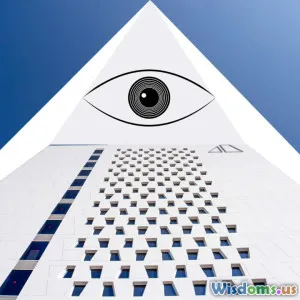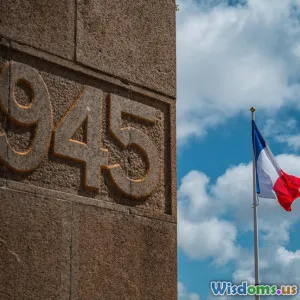
Cracking the Enigma: The Secret Symbolism of Illuminati Architecture
9 min read Unveil the hidden meanings and symbols embedded in Illuminati-inspired architecture worldwide. (0 Reviews)
Cracking the Enigma: The Secret Symbolism of Illuminati Architecture
Architecture often serves as a silent narrative, whispering stories not just through its aesthetic beauty but through encoded symbols often understood only by select groups. Among the most debated and enigmatic are the structures associated with the Illuminati. This so-called secret society is credited with embedding intricate symbolism into monuments and buildings, revealing a hidden layer of meaning close to the heart of global power and mysticism.
Introduction: Architecture Beyond Sight
When gazing at monumental architectures — whether the grand Capitol building in Washington D.C., the pyramid-shaped Louvre in Paris, or the labyrinthine designs of ancient cathedrals — many see just their grandeur or historical significance. Yet a closer look reveals esoteric symbolism designed to communicate obscured knowledge or power hierarchies. The Illuminati, often referenced as the keepers of hidden wisdom and shadow governance, are said to use architecture as a medium for encoding secret messages.
The purpose of analyzing these buildings goes beyond conspiracy; it is about understanding how architecture itself can serve as a language. Symbolism in Illuminati architecture spans numerology, sacred geometry, astronomy, and occult signs, inviting experts and curious minds to decipher the cryptic code beneath marble, stone, and metal.
The Illuminati and Architectural Symbolism: A Background
Founded in 1776 in Bavaria by Adam Weishaupt, the Illuminati aimed to promote enlightenment ideals—reason, secularism, and the rejection of religious and political abuses. Despite suppression, legends suggest that their philosophies seeped into the higher echelons of power, influencing art, culture, and especially architecture.
The reason architecture is significant to the Illuminati concept is its public, enduring nature; buildings and monuments act as time capsules holding encoded esoteric wisdom for initiates or future generations.
Common Symbols in Illuminati Architecture
The Pyramid and the All-Seeing Eye
Perhaps the most iconic are the pyramid and the "Eye of Providence" (the all-seeing eye). Visible on the Great Seal of the United States and famously on the back of the one-dollar bill, the unfinished pyramid symbolizes strength and duration, while the eye signifies divine watchfulness or enlightenment.
Structures such as the Washington Monument and the Louvre Pyramid echo these themes, with deliberate alignments to celestial bodies reinforcing their mystical connotations. For instance, the pyramid at the Louvre does not merely serve as an entryway but as a multifaceted symbol packet referencing Egyptian mysticism and hidden knowledge.
Sacred Geometry and Numerology
Numerology—where numbers embody metaphysical connotations—and sacred geometry dominate Illuminati-related architecture. Buildings often incorporate the "Golden Ratio" (approximately 1.618), believed to create harmony and spiritual balance. This ratio appears in the design of the Parthenon and the Great Pyramid of Giza.
In Washington D.C., street layouts and building proportions also reflect numerological patterns. A famous example includes the distances between significant monuments encoding dates linked to the Illuminati’s founding or important historical events tied to enlightenment ideals.
Duality and the Owl Symbol
The owl, a symbol of wisdom and secrecy, recurrently appears in Illuminati mythos, often subtly incorporated into statues or façade designs. Owls guard knowledge of the night—the hidden or arcane. At the top of the Rockefeller Plaza in New York, a marble owl statue, often called the "Illuminati owl," embodies this motif. Additionally, duality concepts—light vs. dark, visible vs. hidden—are expressed architecturally through contrasting structural elements.
Real-World Examples of Illuminati-Inspired Architecture
Washington D.C.: A Masonic and Illuminati Playbook
The design of Washington D.C. is famously associated with Masonic symbolism, well known for its fraternities with secretive roots. The city's layout resembles a compass and square, primary symbols in Freemasonry and by association Illuminati lore. The Capitol, Washington Monument, and Jefferson Memorial are aligned to correspond with sun positions on significant dates.
Architect and historian David Ovason writes about the symbolic 'zodiac wheel' embedded in the city's plan, positing that these alignments are cosmological designs intended to empower the nation spiritually and politically.
The Louvre Pyramid: Modernity Meets Mystery
Built in 1989 by I.M. Pei, the Louvre’s glass pyramid sparked shock for its modern contrast with classical French architecture. Much speculation surrounds its symbolism: a nod to ancient Egyptian secret knowledge, and the shape itself designed to channel energy or act as a beacon of enlightenment.
The pyramid is also often connected to the Illuminati through the concept of secrecy and initiation, with the transparent glass symbolizing enlightenment made visible to the masses while still guarding the treasures within.
The Bohemian Grove: Not Architecture per se, but Symbolic Spaces
Although primarily a forested encampment used by secret societies including Illuminati-linked elites, Bohemian Grove’s key symbols and structures—such as the massive owl statue known as "Moloch"—demonstrate physical spaces shaped for esoteric significance. Architecturally, the gathering pavilion and surrounding spaces display symbols of primal power and knowledge encoded in design and ritual.
The Purpose Behind Illuminati Architecture
Architecture affiliated with the Illuminati is believed to serve several purposes:
- Communication: Encoding messages only interpretable by the initiated—a secret language of power.
- Power Projection: Manifesting authority and cosmic alignment, reinforcing legitimacy.
- Spiritual/Energetic Influence: Many believe these structures channel metaphysical energies influencing societal consciousness.
- Historical Record: Serving as permanent markers of values, beliefs, and ideological progressions.
Conclusion: Architecture as Hidden Books of Power
Unraveling the symbolism in Illuminati architecture reveals a fascinating blend of art, mysticism, and power politics. This form of covert communication transcends generations, asserting that buildings can be more than mere structures; they are intentional artifacts bridging the seen with the unseen.
Through iconic landmarks, carefully planned cities, and subtle motifs, this secret symbolism invites us to view architecture through a new lens—one that appreciates both aesthetic grandeur and clandestine knowledge.
Whether an expression of true Illuminati influence or a compelling cultural narrative, the patterns and symbols embedded in architecture enrich our understanding of history, power, and human curiosity.
Exploring these mysteries encourages us to look beyond surface appearances to appreciate the profound stories etched in stone and glass—stories waiting for those willing to see beyond the obvious.
References:
- Ovason, David. The Secret Architecture of Our Nation’s Capital. Harper & Row, 1999.
- Knight, Christopher. The Hiram Key: Pharaohs, Freemasons and the Discovery of the Secret Scrolls of Jesus. Kessinger Publishing, 2006.
- Harner, Michael. “The Significance of Pyramids in Occult Traditions.” Journal of Mystical Studies, vol. 23, no. 4, 2010.
Rate the Post
User Reviews
Popular Posts





















